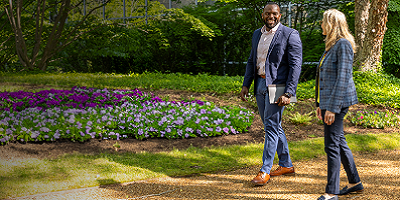Do you have a mentor? If so, you likely realize how valuable a mentor can be. It's an essential relationship — one directly linked to happiness and career satisfaction.
In fact, a CNBC survey from 2019 of 8,000 workers across the country found that about nine in 10 workers who have a mentor are satisfied with their jobs; more than half reported that they are “very satisfied."
Having a mentor is a proactive way to approach your professional development. A mentor can guide you, help you build skills and introduce you to others in your field. However, the relationship also requires effort and diligence on your part. Whether you are searching for the perfect mentor or want to get more out of your current relationship, we have some suggestions for how to get the most out of a mentorship.
Find the right mentor
First, be clear if you're looking for a mentor or a sponsor. A mentor gives career advice, while a sponsor's role is typically to help you get a job you have your eye on. A mentor may very well connect you with a sponsor, but, as this NPR article points out, be careful not to confuse the two.
When it comes to finding your ideal mentor, think about who has the job you would ideally want in 10 to 15 years. Is there a person with that job already in your professional network? Take advantage of any mentorship programs offered by your company or professional associations you belong to. LinkedIn is also a great place to look.
Once you have an idea of who to ask, start with a conversation. "If there is an alignment, then make the bigger ask for mentorship, "advises Mark Horoszowski in the Harvard Business Review. "Asking someone cold to be a mentor with a long email is too much to take in."
Set goals for the mentorship
What concrete things do you want to get out of the mentorship? Discuss your goals with your mentor, and decide if the relationship will be structured or unstructured. In other words, will you have a standing breakfast meeting the third Tuesday of every month, or will you reach out from time to time when you have a specific question or need advice? Set up how accountability will work, as well. Will you email updates and review them in conversations?
Another way to approach a relationship with a mentor is to set a goal of solving a problem together, which tends to be the academic model of mentorship. "Asking for help in solving such problems is a way to more deeply tap your mentor's knowledge and to help that person appreciate your intellect and dedication to the craft," says Michael Schwalbe for Inside Higher Ed. This could be a great chance to work together with your mentor on a project.
Have the right attitude
When working with your mentor, be open to feedback. If you are starting to feel defensive about constructive criticism or advice they offer, try instead to channel curiosity. For example, instead of having a knee-jerk reaction of thinking, "They're wrong!" what if instead, you thought, "That's an interesting observation they made about how I approach my career. How can I learn from this?"
At the same time, don't be afraid to be direct with your mentor and ask for what you need. All of the conversations should be two-way.
It likely goes without saying, but always respect your mentor's time. Also, know when to move on. The average length of a mentor-mentee relationship is a little over three years, according to a study by Olivet University. When it is time to move on, make sure to thank your mentor in writing, with a handwritten note or thoughtful email. And although the more formal relationship may be over, keep in touch with your mentor as you move forward in your career.
Learn more about mentorships and if a mentorship is right for you.
WEB.2076737.08.20





 To exercise your privacy choices,
To exercise your privacy choices,